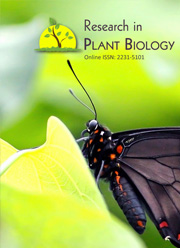Genetic variability and regression analysis for yield and quality traits in Brassica napus
DOI:
https://doi.org/10.25081/ripb.2020.v10.6287Keywords:
Brassica napus, genetic variability, oil content, protein content, regression analysis.Abstract
An experiment was conducted to estimate the genetic variability and regression analysis for yield and quality traits in a set of eight brassica genotypes in a randomized complete block design with three replications at The University of Agriculture Peshawar, during 2011-12 cropping season. Significant genetic variability was recorded among genotypes for plant height, pods main receme-1, pod length, seed yield plant-1, 1000-seed weight, seeds pod-1, oil content, protein content, glucosinolate content, erucic acid content, oleic acid content and linolenic acid content except for primary branch plant-1 and pods plant-1 which showed non-significant differences. Genotypes, AUP-401, AUP-402, AUP-404 and AUP-407 showed potential performance for glucosinolate content (55.1 µmol g-1), seed yield plant-1 (23.93 g), pods plant-1 (268.83), protein contents (21.1 %), erucic acid contents (42.7 %) and oil contents (53.3 %). Seed yield plant-1 was taken as a dependent variable to study the effects of many morphological yield traits on it. Branches plant-1, pods main raceme-1, pods plant-1, and seed pod-1 showed a positive effect on seed yield plant-1, while 1000-seed weight, pod length, and plant height showed a negative effect on seed yield plant-1. Seed yield plant-1 as an independent variable showed a negative effect on oil content. Protein content as an independent variable showed a positive effect on erucic acid content, while oil contents as independent variables show a negative effect on protein contents, respectively. The developed germplasm could be used in the upcoming brassica breeding programs to release high yielding, disease resistance, stress tolerance, and insect resistance varieties, which will eventually upsurge the productivity and decrease the gap between demand and domestic production of the brassica crop.



 .
. 